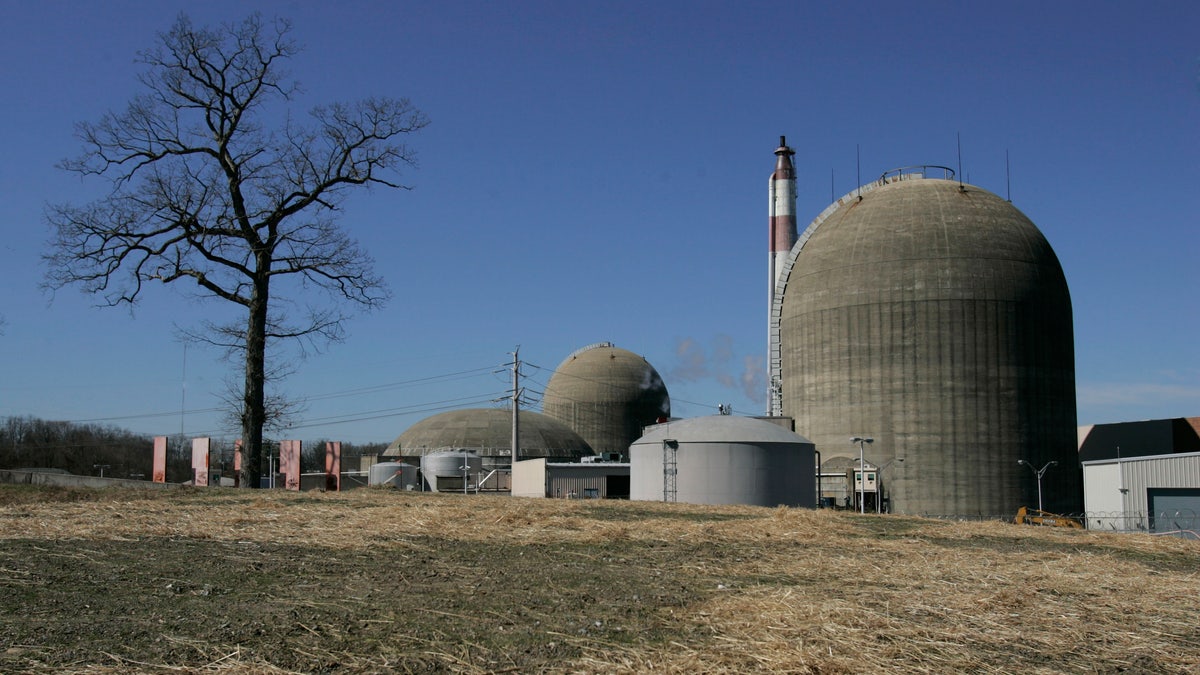
In this file photo, Indian Point nuclear power plant's containment silos, seen here, rise above the skyline along the Hudson River in Buchanan, N.Y. Indian Point 2 is now back online after a Nov. 7 transformer explosion shut down the plant. (AP)
Following the Fukushima nuclear power plant accident in Japan, Americans are worried about the safety of nuclear plants in the U.S. -- and residents living near New York's two-reactor Indian Point plant are no exception. The facility, which sits along the Hudson River in the village of Buchanan just 24 miles north of New York City, has been a big concern for many living in the area.
Representatives with Entergy Corp., the operator of Indian Point, say the nuclear power industry has learned from past accidents but it's too soon to know what changes the recent incident in Japan might bring to the U.S., adding that the facility's emergency plan continues to evolve.
Jim Steets, Entergy's spokesman, tells Fox News, "Emergency planning has become an important part of every nuclear plant in this country since the Three Mile Island incident back in 1979."
When asked about comparisons made between Fukushima and Indian Point, Steets said, "What we do know is that we are prepared for an earthquake 100 times stronger than has ever been experienced here. We know that our emergency diesel generators are at an elevation that protects it from flooding. Those are hugely important when you consider what occurred in Japan."
Still, some local residents say they feel uneasy. Brianna Deacon, who works at Cove Deli in Tomkins Cove says, "You think you're gonna be fine, nothing's gonna happen, but then once you see it happen you really start to get nervous."
That nervous energy has not gone unnoticed. Steets says communicating with the public is a priority right now, which is why the company has taken out ad space in newspapers, bought air time on radio, and has been sending their representatives to town halls and community events armed with what Steets calls "important factual information" to help reassure the public.
The current radio ad running in New York City tells listeners Entergy understands the need to hear from them about the safety of Indian Point.
The radio spot also includes this message: "At Indian Point we've added multiple layers of on-site backup power sources that are safe from flooding to assure our cooling systems will work whenever they are needed. All who work here have complete confidence in the safety of our plants. We continuously upgrade our systems, train constantly and build redundancies in all our operations to assure safety. Our families and friends live here, too. We would not be here if we didn't also believe that Indian Point provides clean, reliable, lower-cost power, safely."
Others aren’t convinced that Indian Point is exempt from a Fukushima-like disaster. Arnie Gunderson, a former nuclear power executive who is now the chief engineer for Fairewinds Associates, believes the Indian Point plant is vulnerable. Comparing Fukushima to Indian Point, Gunderson tells Fox, “Even if the diesels (generators) had been on top of the Empire State Building, they wouldn’t have been able to be cooled because the service water pumps were under water. They have this same problem at Indian Point. If the river were to flood, the pumps wouldn’t have electricity to them and the pumps still wouldn’t run. So we could have [another]Fukushima for other reasons.”
In addition to reminding the public that Indian Point was designed to withstand earthquakes, floods and terrorist acts, Entergy says it puts employees through safety and emergency drills four times a year, and every five weeks, operators go through classroom and simulator training for potential emergency disasters. That's in addition to the federal government assessment that takes place every two years. Steets adds, "They have to be successful. I mean, you don't keep your license if you don't demonstrate that you have the required emergency response capabilities."
Still, lingering doubts hang in the air. A recent push by area lawmakers to enlarge the current 10-mile evacuation zone around Indian Point to 50 miles would require nearly 20 million people to vacate the area, a concept Entergy officials say is not necessary, and locals say is impossible.
Joseph Schroeter, who lives three miles from the Indian Point site, says, "There's just no way that with New York City being so close, that enough people could get out quick enough," adding, "Unless it happens you don't know, you know? Probably if people were to ask people in Japan prior to what happened, they probably, most of the people that were in charge of operating the plant would have said that you know, we think we have a good safety program here, and that didn't turn out to be true."

